This gluten free artisan bread is the crusty bread you thought you'd never have again. One bite and you'll be in absolute HEAVEN! Better still, NO ONE will know it's gluten free!
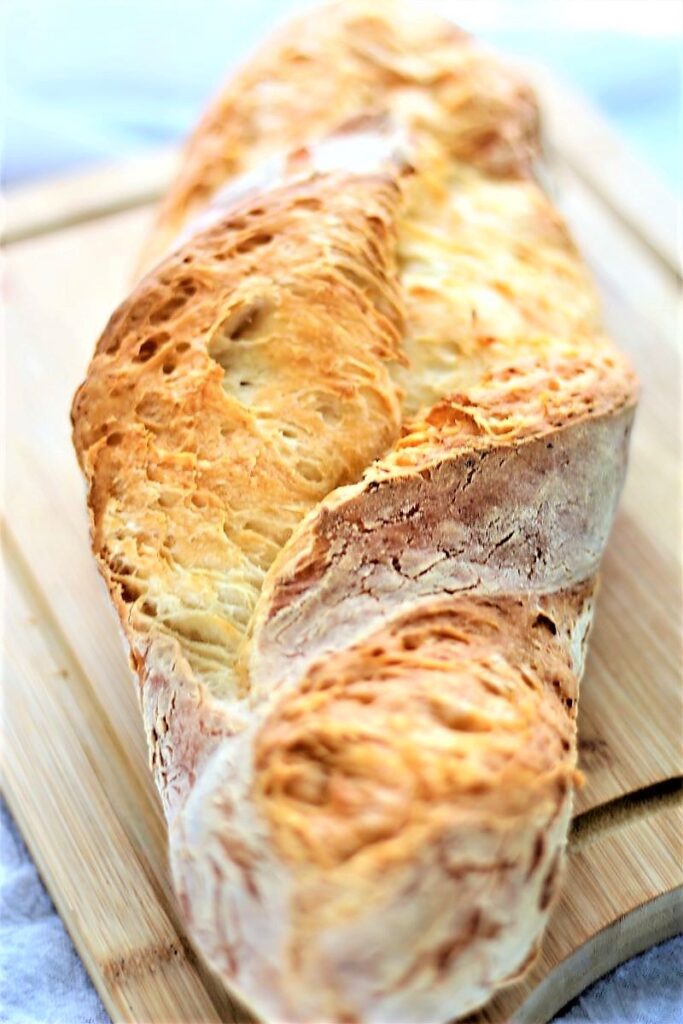
Some of the items linked in this post are affiliate links, meaning, at no additional cost to you, if you click through and make a purchase, I will earn a small commission.
This bread started out as pizza. Well, pizza dough. When I created my gluten free pizza dough, the whole family absolutely loved it. And none of them are gluten free, which to me always says a lot. When you feed something gluten free to people that don't need to eat gf and they love it, you know you've done it. So what else could I make out of this dough?
The most logical idea was artisan bread, mainly because it's made with the most basic ingredients. Flour, water, yeast, and salt (with a tiny amount of olive oil and honey) are transformed into something almost otherworldly. It's crusty on the outside with a perfect chew and an open crumb. Would it work though?
The answer is a resounding YES!!!! This artisan bread was the first gluten free bread I ever created, and it's been a staple in our home since.
HOW I CAME UP WITH GLUTEN FREE ARTISAN BREAD
I wish I could say that the whole idea behind this bread was mine and solely mine. But that would be a lie. A while ago I came across the cookbook from Jeff Hertzberg, M.D. and Zoe Francois called Gluten Free Artisan Bread in Five Minutes a Day. Their idea for artisan bread taking only five minutes a day was absolutely revolutionary!!
I decided to use my gluten free pizza crust dough in place of their recipe for gluten free bread dough. WOW!!! The bread was GLORIOUS!! And they were so right about the 5 minutes-a-day thing. It literally takes only FIVE minutes of hands-on time!!
MAKING THE DOUGH
As I stated above, the dough for this gluten free artisan bread is the very same dough for my AMAZING gluten free pizza crust. If you haven't tried that yet, you really don't know what you're missing. My whole family loves my pizzas and none of them are gluten free.
Mixing the dough is just as easy as any other dough recipe on my site. Whisk the dry ingredients together in the bowl of a stand mixer. You can use a handheld mixer, but it'll take a lot longer. You could also use a Danish dough whisk (affiliate link), but just make sure to beat it well so that everything incorporates. Add the wet ingredients and continue to mix on low until well incorporated. Increase the speed to medium high and knead for a solid 5 minutes. I always set a timer and walk away.
Remove the bowl from the machine and, using a bowl scraper like this one (affiliate link), scrape the dough into a cohesive mass. Alternatively, dump the dough into another bowl for rising. Cover the bowl with plastic wrap and allow the dough to proof (rise) in a warm, draft-free area until doubled in size, 1-2 hours.
After the dough has risen, place it in the refrigerator to chill for at least several hours (5-6) and up to 10 days. The longer it sits, the more fermentation happens and the more it takes on the flavor of a sourdough bread. The extra fermentation also helps with development of the bread structure, which makes for a better loaf of bread. There is no gluten development so gluten free bread baking needs all the help it can get.
SHAPING THE BREAD
The typical shapes of loaves for our family are baguettes and boules, but be creative in your own kitchen and make any size and shape you'd like. I often find myself perusing regular (gluten-filled) bread baking blogs and cookbooks looking for different ways to shape my bread.
- TO SHAPE A BAGUETTE OR BATARD -- (a shorter, wider loaf), roll into a rope shape, tapering at the ends. Place on a piece of parchment long enough to fit the baguette (you may have to position it diagonally). I like to place mine on a pizza peel (affiliate link) to make it easier to transfer it into the oven.
- TO SHAPE A BOULE -- simply knead the dough as instructed and mold it into a large round, tucking the ends under the bottom of the round. Again, place it on a piece of parchment and set on a pizza peel (or overturned baking sheet) for easy transfer to the oven.
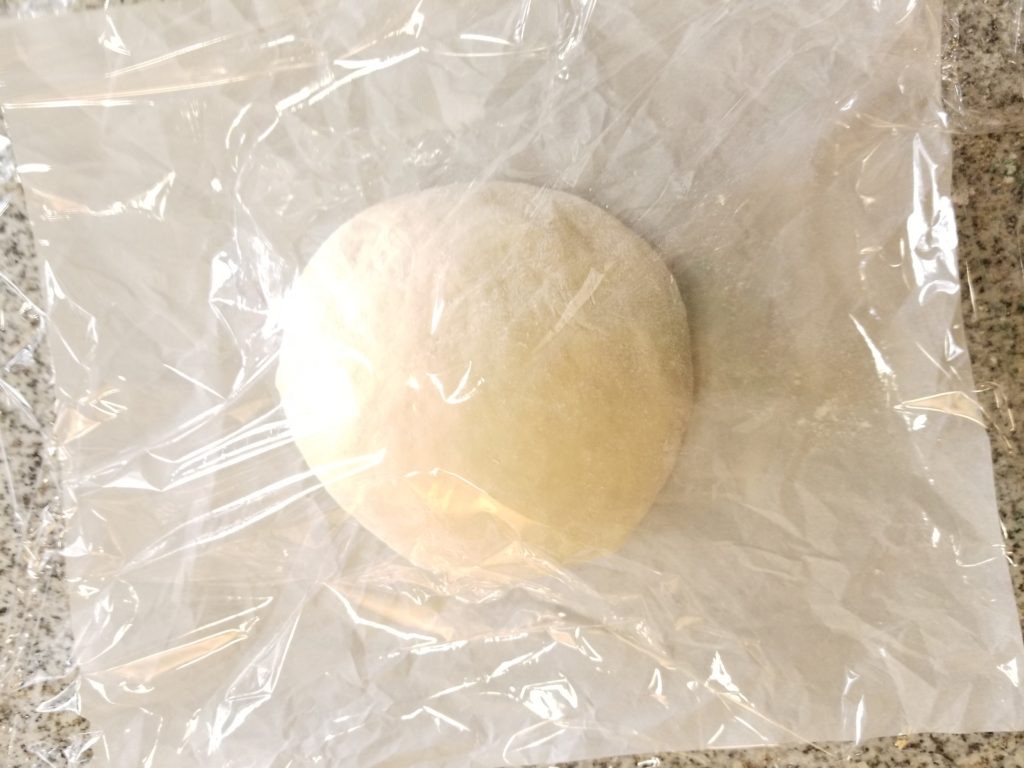
Most bakeries bake their breads in steam ovens. Steam ovens release steam at the right time when breads are baked. Again, I took a page from Gluten Free Artisan Bread in Five Minutes a Day. Take a shallow pan, such as an old broiler pan, and put it on the bottom rack of your oven. Put a baking steel (affiliate link) or baking stone (affiliate link) on the middle rack and preheat the oven to 450 degrees.
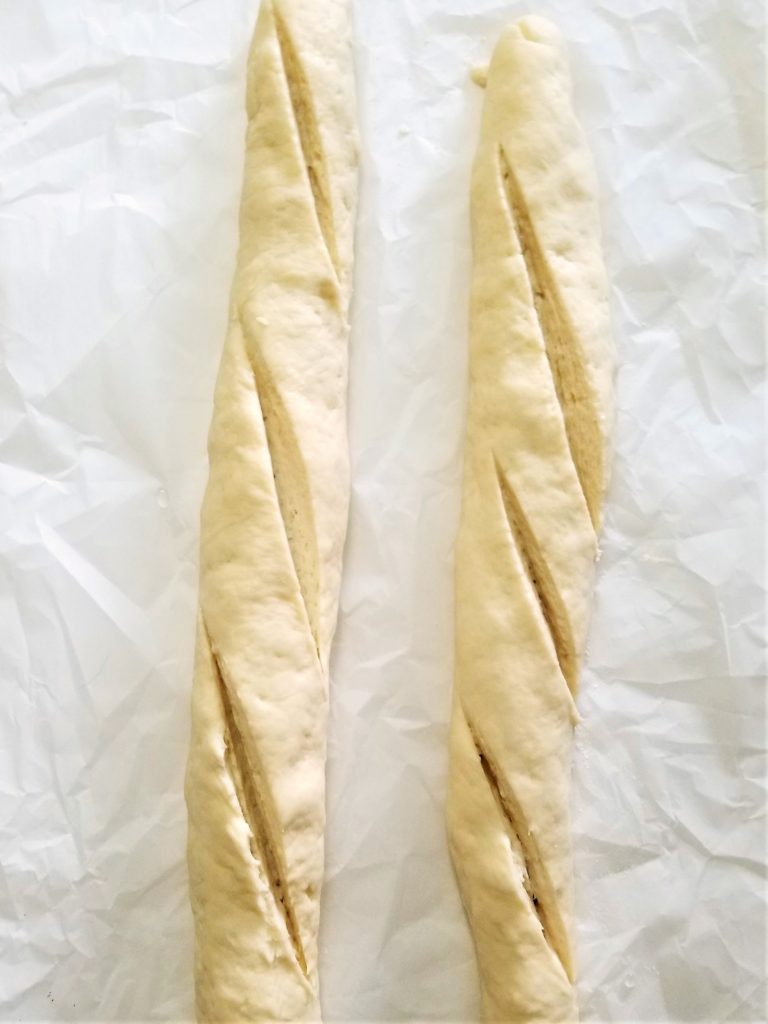
When the dough has fully proofed, slash it with a wet, sharp bread knife or lame (affiliate link). You can be creative with your slashing as well. Slide the shaped bread into the oven, parchment and all, onto the steel (or stone). If you don't have a steel or stone, an overturned baking sheet will do in a pinch.
Carefully pour a cup of hot tap water into the broiler pan, which creates instant steam. Quickly shut the oven door to keep the steam in. This allows the bread to gain its initial rise (oven spring) in the oven before the crust begins to set.
gluten free artisan bread fAQs
If you something other than my bread flour blend, or alter my blend in any way, you will NOT get the results that I show you in the pictures and video. This is the main reason I developed my own flour blends, because no store bought blend was able to give me the results I was looking for.
You bet! Baking with yeast requires some patience and often just learning from your own mistakes. So how do you know when your loaf is properly proofed? First, don't pay so much attention to time. Proofing times given for any recipe are just guidelines and aren't set in stone. Sometimes my house is colder and it will take a small loaf over an hour to rise. Other times, like in the summer months, 30 minutes is all a loaf needs.
Covering the dough is crucial because it will prevent a skin from forming, which would inhibit oven spring (the rise of the dough once it hits the hot oven). This will cause a very dense, brick-like loaf.
If you don't have a shallow pan, you can also throw a handful of ice cubes right onto the bottom floor of your oven before quickly closing the door. Another option is to spritz the bread directly with water in a clean spray bottle.
The best judge is to feel the weight of it. If it feels at all heavy, it's not done. Put it back in the oven for another 5-10 minutes. Baking time is usually considerably longer with almost all gf baking than their gluten-filled counterparts. If you've made a larger or thicker loaf and it takes more than an hour to bake, don't be surprised. If your bread is getting too dark, just cover it loosely with foil while it continues to bake.
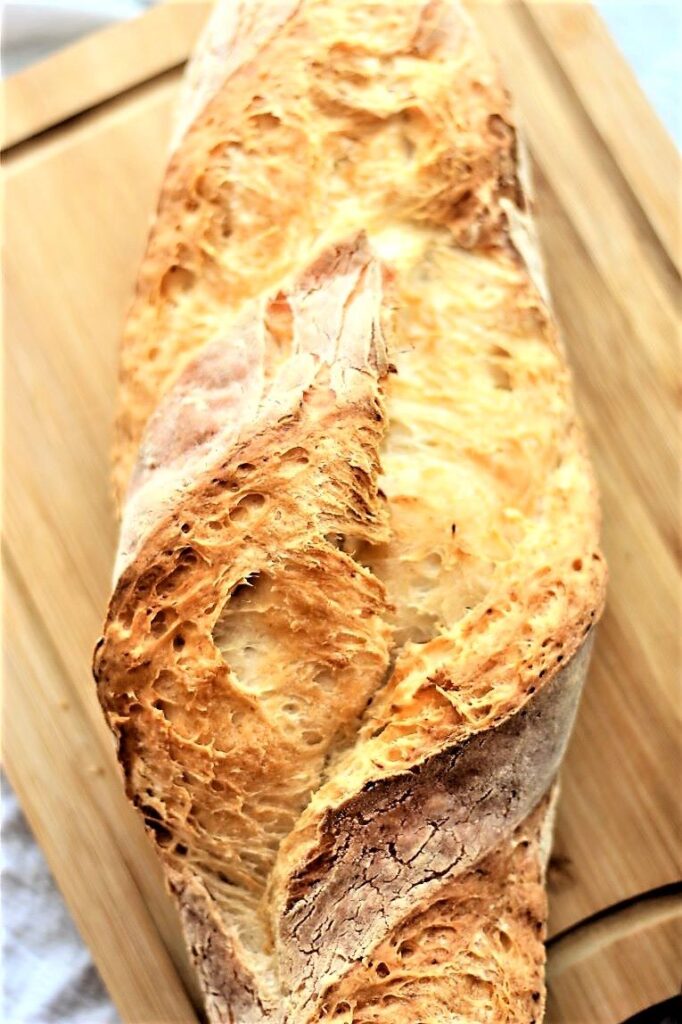
A word about psyllium husks
In the recipe, you'll find measurements for using this wonder ingredient. However, if you don't want to use it or can't find it in your area (or don't want to order it online), you can make this bread without it and it'll still be AMAZING! You will just have a stickier dough that's a little harder to shape. It won't affect the quality of the baked bread.
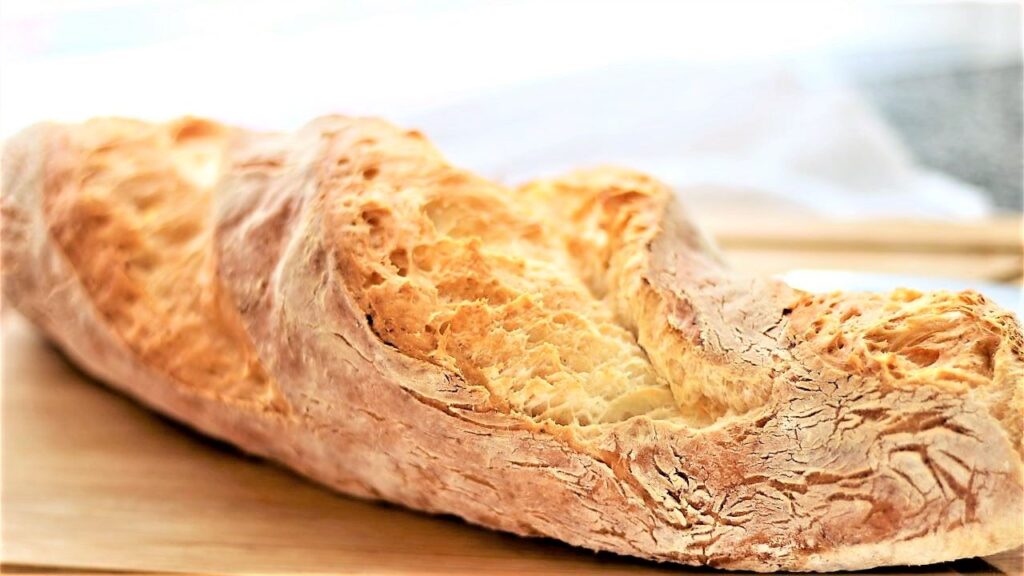
What are you waiting for? With a little bit of time and a few tools, you could be in bread HEAVEN!!
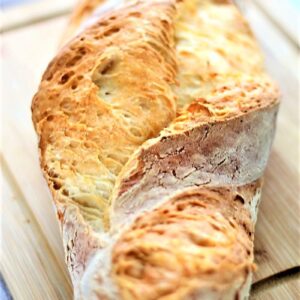
Gluten Free Artisan Bread
Ingredients
- 3 cups (420 g) Kim's gluten free bread flour blend
- 1½ teaspoon xanthan gum (in addition to what's already in the blend)
- 1 tbsp (5 g) psyllium husks* (or 1 ½ teaspoon psyllium husk powder)
- 1 tbsp (9 g) instant/rapid rise/fast-acting yeast (not active dry yeast)
- 1 teaspoon kosher salt
- 1¾ cups (420 ml) water*
- 2 tbsp (26 ml) olive oil
- 1 tbsp (21 g) honey
Instructions
- In the bowl of a stand mixer fitted with the dough hook, add all dry ingredients and whisk using a handheld wire whisk. Add the honey, olive oil, and water. Place on mixer and mix briefly to incorporate. Turn the mixer up to medium high and knead for 5 minutes. Remove the dough hook and scrape the dough into a cohesive mass using a plastic dough scraper or a rubber spatula (or scrape into another bowl). Cover and place the bowl in a warm, draft-free area and allow it to rise (proof) for 1-2 hours, or until doubled in volume.
- Refrigerate for at least 6 hours, preferably overnight, but up to 10 days.
- On baking day, remove the dough from refrigerator and dump it out onto well-floured surface. Knead until fairly smooth, adding more flour as necessary. If not using the psyllium husks, it will be a somewhat sticky dough so keep a small bowl of flour on hand to sprinkle the dough and/or surface with extra flour.
- To shape into a boule, simply form into a round ball, pulling the dough up and under the ball and pinching on the bottom. Place on parchment paper. To shape into a baguette, smooth the dough and roll into a rope shape, tapering it at the ends, adding more flour as necessary. Roll out as thick or thin as you'd like and as long as you're able to fit in your oven (make sure it will fit on your pizza steel or stone). Place it on a sheet of parchment paper.
- Place the loaf or loaves, covered loosely with plastic wrap, in a warm, draft-free area to rise until visibly puffed and slightly larger, but not doubled in size, about ½ to 1 hour. This time will vary depending on the warmth of your proofing area.
- BAKING STEEL OR STONE METHOD: Set up your oven for baking. Place a baking steel or stone (or overturned baking sheet) onto the middle rack with a shallow pan on a rack underneath. Preheat the oven to 450° F.
- DUTCH OVEN METHOD: Place a Dutch oven with a tight-fitting lid into the oven and preheat it to 500° F. You won't need the shallow pan with steam as enough steam will be created in the Dutch oven once the bread goes in. NOTE: This will only work with boules or loaves that can fit into the Dutch oven. If you're making a longer batard or baguette, you'll need to use the first method.
- When the dough has finished rising and is visibly puffed, run a serrated knife under hot tap water and cut slits in the dough swiftly but uniformly, about ½-¾ inch deep.
- BAKING STEEL OR STONE METHOD: Fill a measuring cup with one cup of very hot water (from the tap is fine). Using a pizza peel (paddle), slide the loaf (or loaves) onto the baking steel (or stone), parchment and all. Immediately pour the cup of very hot tap water into the shallow pan. Quickly shut the oven door.
- DUTCH OVEN METHOD: Remove the lid carefully and carefully lower the dough, parchment and all, into the Dutch oven. Replace the lid and shut the oven door. Immediately reduce the temperature down to 450° F.
- BAKING STEEL OR STONE METHOD: Bake for about 30 minutes for baguettes, or about 40 minutes for boules, OR longer for larger boules (some larger boules can take up to an HOUR or more). If the loaves are getting too browned, you can cover them loosely with foil. The loaves will look crusty and done on the outside, but will feel light when picked up. If they feel heavy, they're not done yet. Allow them to bake for another 5-10 minutes and then check again, picking up the loaf with two gloved hands. If they're still feeling heavy, allow them to bake for another 5 minutes and check again.
- DUTCH OVEN METHOD: Bake the bread for 40 minutes with the lid on. Remove the cover and continue to bake for another 20 minutes. Check for doneness by picking up the loaf (with gloved hands). If the loaf feels relatively light for its size, it's done. If it feels at all heavy, it's not done and give it another 5-10 minutes before checking again.
- Remove from the oven and place on a cooling rack. Allow to cool COMPLETELY before cutting (or it will be gummy on the inside).
Notes
- The recipe makes about 2-3 loaves of bread, depending on how large or small you make them. You don't have to make them all in one day. You can leave the rest of the dough in the refrigerator for another day when you want freshly baked bread.
- You can double or even triple the recipe (if you have a mixer big enough to handle the dough). A double recipe fits well in my 5-quart Kitchenaid artisan mixer.
- Extra dough may also be frozen. Wrap in plastic wrap and then in foil and place in the freezer for up to 3 months. Thaw in refrigerator overnight and then use as normal.
- The possibilities are endless with this dough. It can be made into so many different shapes and sizes of loaves and you can shape it in about five minutes a day. You can make pizza with half of it, and bread with the other half! If you only want to make one loaf in a day, only take out the amount of dough you'll need for that loaf (usually about a softball to grapefruit-sized amount). Again, it depends on the size and shape of loaf you're making.
- The dough will last in the refrigerator for about 10 days, fermenting even more (like sourdough) each day. It actually gets better with age 🙂
- *If you don't want to use psyllium husks or psyllium husk powder, decrease the amount of water in the recipe to 1 ½ cups (360 ml).
- FOR HIGH ALTITUDE BAKING: Per Beth, who lives in Colorado and graciously offered some high altitude baking conversions, "the crust is perfect – crisp without being like a cracker and enjoyable to bite into. The crumb was perfect, and light which is no small feat considering it is gf. I followed Kim’s recipe for the flour blend. I then adjusted the following in the recipe: Yeast: 2.5 teaspoon + ⅛th teaspoon (reduced each teaspoon by ⅛th tsp). Salt: 1.5 teaspoon (added ½ tsp). Water: 1.5 c. + 3 tablespoon added 2 tablespoon per cup). I followed the rise times and baking directions exactly. I made 2 loaves: one baguette and one boule. I baked them on my baking stone as directions state. My loaves took 2 hours to grow noticeably larger during the rise after being in the refrigerator overnight. I turned the oven on then off, then put the loaves on a wooden cutting board covered with plastic wrap and also a light cloth while rising. I have a family member who has celiacs and I am gluten and dairy intolerant. I used the pea protein, by the way."
Inspired by Gluten Free Artisan Bread in Five Minutes a Day
This bread was originally posted on October 12, 2018 and has been updated with new images, a video, and more step-by-step in depth information.



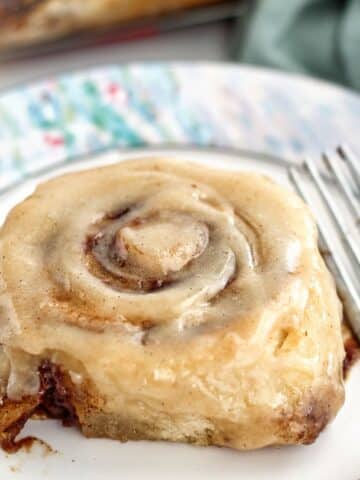

Julie Parker
I tried this recipe yesterday/ this morning.
I got the best bread I've ever made. Absolutely AMAZING. But I had to make a few changes - here they are in case it's helpful to anyone, particularly in the UK.
Firstly I accidentally ordered whey protein concentrate instead of whey protein isolate, and I used it in the flour blend. It was this brand: MyProtein Impact Whey Protein - Unflavoured 250G at £17 for 250g.
I used Shipton Mill Tapioca Starch and Shipton Mill White Rice Flour, and Just Natural Organic Psyllium Husk, and Tropical Sun Potato Starch (which on the packet is called "Farina"). I used FREEE Xanthum Gum and Doves Farm Quick Yeast. I used normal table salt.
When I mixed the dry and wet ingredients together ( I used a paddle attachment not a dough hook because I couldn't find the dough hook!), it was totally wet and sticky, like cake mix - there was no way it was going to work. When I looked closely at my rice flour I realised it might not be fine enough. The description said their white rice flour was ground finer than their brown rice flour - but I realised that might not be superfine enough, and I decided that might be why the dough was so sticky, from reading the other comments.
So I gradually added 4 heaped tbsp of Schar Pizza Flour (which incidentally is exactly the same as Schar Mix B but much cheaper), and a heaped tbsp extra rice flour. It had by now become a bit less sticky, but not much.
As I had changed the flour amount so much by now and messed with the ingredients, I was fairly sure it would fail, but in any case I proceeded with it. I proved it in the oven - for some reason I can only ever get dough to rise if it put it in a lidded saucepan at 50C - and after an hour it had more than doubled.
I put it in the fridge overnight and decided I would see how it looked in the morning.
So this morning I dumped half of it on a floured board - with great difficulty as it was a sticky mess - and after I added more flour (probably about another heaped tbsp) and worked it a bit, folded it a few times etc, surprisingly it actually it became more of normal-looking solid mass, so I decided to shape it, prove it and bake it anyway and see what happened. I went for a "Fat Batard" shape and I gave it a full hour proving in the lidded saucepan at 50C. I baked it on an overturned baking tray, with hot water in another tray below, at 230C.
I checked it after 30 mins and it felt a bit heavy so I gave it 5 mins more, and then another 5. It looked great when it came out, but I was still fully expecting a failure. After 45 minutes cooling I cut it open and it was ABSOLUTELY PERFECT. Best bread I've ever had, even including my gluten days. It had a lovely crust and a soft inside, it was perfectly cooked and it tasted great.
So there you go 🙂
I have now ordered some Tropical Sun Rice Flour which is supposed to be superfine, and when that comes I'll try this whole thing again and see if it still needs all that Schar Pizza Flour. Then I'll know if the rice flour was the problem.
Hope this is helpful!
Deb Roberts
Hi Kim
My husband is coeliac and we are just thrilled to find a recipe for flavoursome crusty bread. He says it’s the best bread he’s had in the 6 years from when he was first diagnosed, so thank you so much.
Kim
Awe, that is so awesome!!! I love hearing stories like yours because I've been there and I know how it feels.
Kiki
Kim, everything I’ve tried of yours turns out more delicious than its gluten counterparts. I’m so appreciative.
Question, I am looking to make some bread for a torta which is basically a crusty roll for a sandwich. Is this the recipe you would use? Would you think this recipe would make 6-8 rolls? Thanks so much
Kim
Yes!! Check out my recipe for crusty French rolls. It's essentially the same dough recipe, just different shaping technique and baking times. Here's the link: https://www.letthemeatgfcake.com/gluten-free-crusty-french-rolls/
Melissa
First and foremost, I want to thank you so much for your amazing recipes that I have recently found! I credit you for my gluten-free bread journey that I started about 3 weeks ago. I enjoy it so much and you have made that possible!
Thank you again! I had one quick question in regards to this recipe do you have measurements if I didn’t want to make three loaves and let’s just say I wanted to make one or two or do you have to use these measurements? Thank you 🙂
Kim
You can definitely halve the recipe if that's what you're asking.